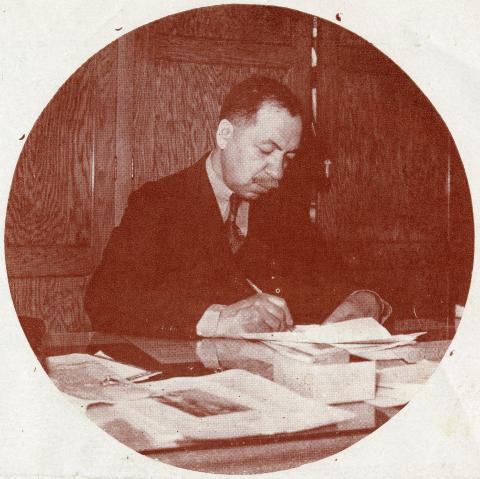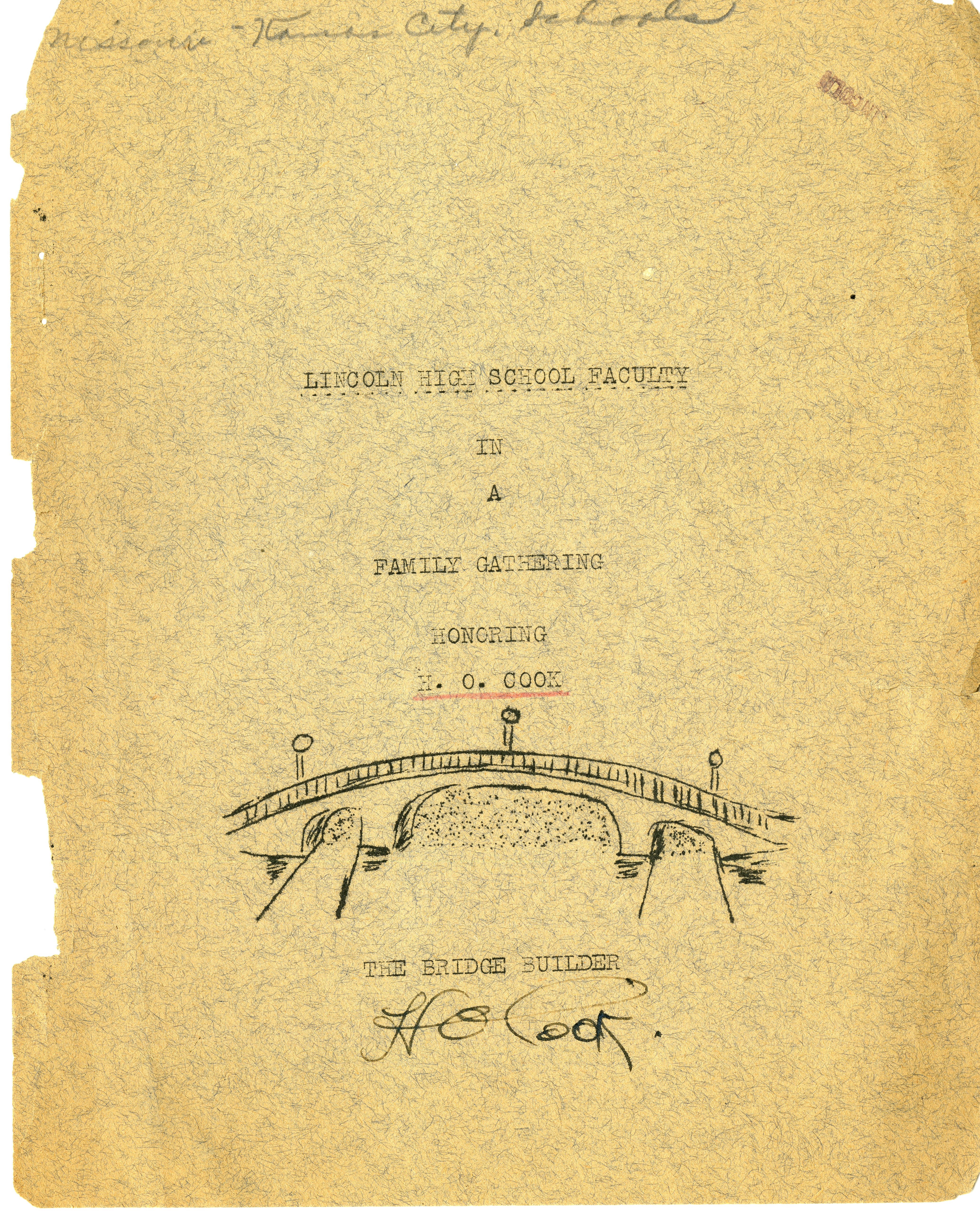Hugh Oliver (H.O.) Cook

- Date of birth: October 31, 1873
- Place of birth: Washington, D.C.
- Home: 2436 Montgall Ave.
- Claim to fame: principal and educator at Lincoln High School
- Political affiliations: Republican Party
- Spouse: Myrtle Foster Cook
- Date of death: April 15, 1949
- Final resting place: Rosedale Cemetery, Los Angeles
Over the duration of 40 years at historically black Lincoln High School, Hugh Oliver (H.O.) Cook shaped the school’s culture and curriculum, both as a mathematics and psychology instructor and later as principal of the institution from 1921-1944. A Washington, D.C., native and a graduate of Cornell (with a Bachelor of Arts and Master of Arts in Secondary School Administration), Cook’s vision for Lincoln High to serve and connect to the Kansas City region’s black community continued a legacy set by the school’s earlier principals, including his immediate predecessor, John R.E. Lee.
Lee was so beloved that, upon leaving his position, he felt compelled to make a tour of speaking appearances to appease the public. Cook, indeed, seemed to have large shoes to fill, but his previous level of recognition made him an impressive candidate. The board of education unanimously approved Cook for the role of principal because of his lengthy service and community work. Cook had led the campaign in the 1910s for construction of a Young Men’s Christian Association (YMCA) facility for African Americans. He also served overseas during World War I as the YMCA secretary, representing the association in an all-black unit, the 371st Infantry Regiment. Cook was recommended for the Distinguished Service Cross after being gassed in the fall of 1918 during the Champaign offensive in France, and he was lauded as a hero upon his return.

During Cook’s tenure as principal of Lincoln High, the school—although composed of outstanding instructors and leaders—also faced sizeable issues relating to funding, resources, and particularly, poor facilities. Cook and members of the community advocated for a new high school to replace the facility that had housed Lincoln High at 19th and Tracy since 1906. Even as multiple plans for new white school buildings progressed, and as some other projects important to the African American community gained approval (including Pendergast machine-backed bonds for a new General Hospital No. 2 building in 1925) a bond issue for Lincoln High failed with voters in 1927, and the all-white School Board ignored the pressing need.
In the late 1920s, the high school’s structure held 1,100 students in a facility built for 800. Makeshift classrooms were set up in wooden frame buildings attached to the main brick building, and even the all-white School Board could no longer ignore the deficiencies. It was at Cook’s urging that the new Lincoln High building be erected centrally to the segregated black neighborhoods of Kansas City and within walking distance of 63 percent of the city’s black students. The new building at 2111 Woodland was finally finished in 1936, when it opened as a high school and junior college.
H.O. Cook had long been outspoken in his critiques of racial discrimination and segregation, and as principal and spokesperson for Lincoln High, he remained active in the broader black community. In the annual Boys’ Loyalty Parade, put on by the school board and Rotary Club, Cook urged black students to refrain from joining because organizers segregated black children to the end of the line. Additionally, Lincoln High’s curriculum promoted study of black culture and history, and this contribution seems attributable in large part to Cook, who helped incorporate this curriculum into the social studies department. In 1940, after nearly forty years at Lincoln High, Cook received the Missouri State Association of Negro Teachers' Distinguished Service Medal award for “building a life.” He had served as the association’s secretary for twenty-one years and as president in 1923. Lincoln High School alumni and later, teacher, Jeremiah Cameron remarked in a 1976 interview that as students,
we knew about Negro music, Negro literature, and Negro achievements [because Principal Cook] kept that before us.
Cook met Myrtle Foster when she joined Lincoln High’s faculty in the English department, and they married in 1916. Myrtle Foster Cook was a clubwoman, educator, editor, and political and civic worker in her own right, and by all accounts she and H.O. Cook held much sway in local and wider movements. She was active in the Republican Party and served as the national program chair of the National Association for Colored Women from 1918-1928. Myrtle Cook was also active in the Book Lover’s Club, the City Federation, and the Women’s League. She held the position as second editor of the association’s newsletter in 1922 and maintained frequent correspondence with prominent women’s and civil rights activists, including Mary Church Terrell, Mary McLeod Bethune, and Hallie Quinn Brown.
As a couple, H.O. and Myrtle Cook were active supporters of the black population in Kansas City, donating much of their time and money to organizations and individuals, especially high school and college students. Myrtle spearheaded support within the Women’s League to establish a home for African American boys and worked nine years to resolve the building, resources, and staff for the Jackson County Home for Negro Boys. H.O. was a founding member of the NAACP Kansas City branch, while Myrtle was also active in that organization and held the position of secretary and treasurer for many years. The pair were involved in creating the Paseo branches of the YMCA and YWCA, serving young black men, boys, women, and girls in Kansas City. They were also active in the Urban League.

Much of the Cooks’ outreach efforts transformed from a sense of civic duty into a personal realm. The Cooks had no biological children of their own, although H.O. came into the marriage with two sons, Hugh Oliver Jr. and Hartwell, as well as a foster daughter who was in college, named Chloe. Still, the Cooks provided aid, care, and love to several children and young adults in Kansas City, some of whom they reportedly informally adopted as their own children. During their life together, contemporary news sources estimated the Cooks provided some sort of support to “dozens” of children, including providing financial aid for high school and/or college. Thus, in addition to activism relating to organizations and institutions, the Cooks also directly impacted many individual lives.
H.O. Cook retired in 1943 after 42 years at Lincoln High School, and George S. Ellison became principal in 1944. The Cooks moved to Los Angeles County for the duration of their remaining years, continuing activism in their new community; H.O. was involved in the Boy Scouts, sold real estate and fire insurance, and the couple raised funding for a low-income housing project. H.O. died two years before his wife, on April 15, 1949, in L.A.’s white Memorial hospital after complications from an operation. Newspaper reports both in the Kansas City Call and in Los Angeles County called the Cooks “‘part and parcel’ of every forward movement which took place in Kansas City over a period of 40 years.” Following the announcement of H.O.’s death, a memorial service held at Lincoln High in his honor and reported in The Call attracted teaching colleagues, students, school district administrators, and citizens from the Kansas City community.
Hugh Oliver Cook remains an impressive figure in Lincoln High’s history, and his activism for equity in the Kansas City School District profoundly influenced not only Lincoln High’s trajectory, but also that of many individual black students during the height of segregation. Cook shaped the culture at Lincoln High during the height of Jim Crow and segregation in education, and his service to the black community, along with that of his wife, Myrtle Foster Cook, was far-reaching. The Cooks both affected local and national African American organizations through decades of service, and they helped numerous black youth and children gain further stability, financially and emotionally, during a time in which educational barriers were immense.
Additional support from the Missouri Humanities Council.
Special thanks to Dr. Michael Sweeney for research assistance.
This work is licensed under a Creative Commons Attribution-NonCommercial-NoDerivatives 4.0 International License.
